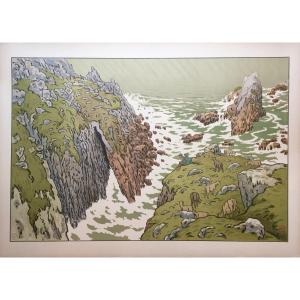- in verygood condition
- MonstrousReality -
Inspired bythe art of Guiseppe Arcimboldo, Reiner Schwarz creates heads from interlockingparts, except that these are not elements of flora and fauna, but parts of thehuman body. The monstrous effect is heightened by the fact that one of thefaces is a raised mask behind which the true face is revealed. The mask of theVenetian Renaissance beauty is much blander than the actual ugly face satirizedby the peacock feathers, which nevertheless displays an expressive andmysterious beauty in its own way, even if it contradicts the formulated idealof the mask. By addressing the art of the Renaissance with the beautiful femalemask, the painting is also a commentary on art history, which, instead ofrecognizing the monstrous reality, depicts the fantasy world of ideal beauty.
About the artist
After being expelled from Hirschberg inSilesia, Reiner Schwarz spent his youth in Hannover. In 1960 he began studyingat the Hochschule der Künste in Berlin with Mac Zimmermann and produced hisfirst lithographs. In 1962 he made study trips to Florence and Venice, and in1965 to Rome. He was particularly fascinated by Italian art, Sienese painting,and Mannerism. His first solo exhibition at the Galerie Schnoor in Bremen in1964 was the beginning of more than 150 exhibitions in Germany and abroad.In 1974 Reiner Schwarz established a printstudio in Berlin, where he perfected the technique of lithography, using up to17 colors on various tone papers. In 1987, his artistic encounter with RolfMünzer and Peter Schnürpel at the Kätelhön print studio inspired him to explorethe world of "abandoned and lonely" everyday objects as melancholytraces of memory instead of people. Initially, he used large-format wrappingpaper from the GDR. In 1990 Schwarz became a member of the Künstlersonderbundin Germany.Galerie Brusberg, which represented the artistfor more than 20 years, published a catalogue raisonné of Reiner Schwarz'slithographs in 1984. "He does not want to be just adraughtsman, but an interpreter, a reinterpreter, a metaphorist who createsmutants and thus visualizes the invisible, the known and the seemingly banalthat is about to be transformed into eternity; the brief moment of an all toofleeting present, nature next to nature, reality next to reality. It istherefore a subversive realism that questions our everyday thinking, thatrefuses to grasp things quickly by means of exaggerated precision, that thwartscognition, denatures the world and melts it into a pictorial puzzle[...]".Edwin Kratschmer
































 Le Magazine de PROANTIC
Le Magazine de PROANTIC TRÉSORS Magazine
TRÉSORS Magazine Rivista Artiquariato
Rivista Artiquariato